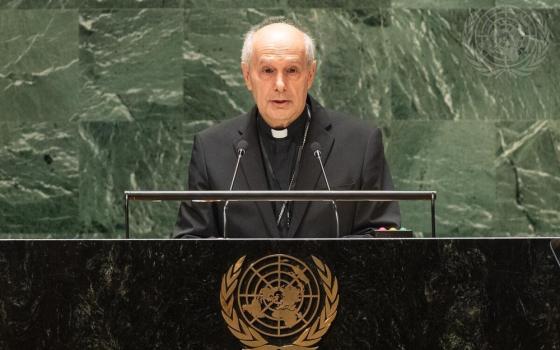
Haiti Dispatches
Editor's note: Gerry Straub, a filmmaker who has placed his art "at the service of the poor," is in Haiti and will be reporting by phone when possible during the next week. More than 15 years ago, Straub gave up a lucrative career producing daytime television to explore the interplay between creativity and spirituality. He underwent a deeper conversion while doing a book on St. Francis of Assisi, and for the past 12 years, he has documented the plight of poor people around the world.
In early December, he traveled to Haiti to begin filming a documentary titled "Angels of Compassion: the Luminous Force of Intentional Kindness." He spent time filming work being done in Haiti's Cite Soleil, described as the worst slum in this poorest country in the hemisphere. He returned Jan. 21.
PORT AU PRINCE, Haiti -- When Gerry Straub landed at the airport at Port au Prince the morning of Thursday, Jan. 21, he described the scene as "organized chaos," with countless people seeking treatment for all manner of injuries and planeloads of supplies arriving regularly.
Logistics were being handled by U.S. military personnel, he said, and he saw huge cargo planes being quickly offloaded and turned around. Other planes with supplies landed regularly, he said.
The plane he arrived in carried 22 other passengers, all doctors and nurses from across the United States on a flight chartered by CURE International, a non-profit organization that establishes and operates teaching hospitals in the developing world for the medical and spiritual healing of disabled children and their families.
The group eventually boarded an old school bus and with their supplies (Gerry was on the roof to better film the scenes) made their way into the heart of Port au Prince. The drive usually takes about 45 minutes but on this occasion, it took two hours. Their destination was the Haitian Community Hospital on Rue Audant, near the Petionville district, reportedly one of the hardest hit areas of the city. The hospital was damaged, according to reports, but was still accepting patients, though several days in to the tragedy was running low on supplies.
"This is beyond insane," said Straub, of the trip from the airport to the hospital. "I can't tell you how many people were lining the street -- people screaming and begging for anything, anything to eat." At one point he saw hundreds of people running after two trucks that contained food supplies.
At the hospital, the scenes were grimmer than any news reports could show, he said, with children and adults lined up on beds in the street outside the hospital, many with missing limbs damaged in the quake. In a walk through the patients with an interpreter, Straub said, he saw minor surgeries being performed in the street.
Inside, he filmed doctors performing more serious procedures, including orthopedic surgery on a woman's legs, without anesthesia. Following surgery, he said, patients are moved to the sidewalk outside the hospital.
Straub said he met Hungarian, Swedish and Korean doctors and was told there were physicians and nurses from a number of other countries, as well as those from the United States, at the site.
He said he would probably be spending the night on the roof of the hospital.
[Tom Roberts in NCR editor at large. His e-mail address is troberts@ncronline.org. Gerry Straub is a filmmaker, who in December was in Haiti working on a documentary titled "Angels of Compassion: the Luminous Force of Intentional Kindness." He returned to Haiti Jan. 21 for more filming. While there, he filed reports for NCR by phone.]
| All the stories from the " Haiti Dispatches " series
For more information on the foundation Straub created, The San Damiano Foundation in Burbank, Calif., and to read about and order his films, please see www.sandamianofoundation.org. |
More about Gerry Straub
"I make movies no one wants to see, with money I don't have," Straub jokes. Straub has produced eight documentaries chronicling the plight of the poor in 11 international locales such as Peru, El Salvador, the Philippines and Kenya, as well as in the poverty-ridden ghettos of Los Angeles and Philadelphia.
To say no one wants to see his movies, however, is a bit of a stretch. Straub and his work have been featured in the Los Angeles Times, and he appeared on the cover of The New York Times' arts section on Christmas Day 2004. The University of Notre Dame, the Catholic Theological Union in Chicago, and scores of other universities, high schools and parishes have screened his films.
It was St. Francis' example, and the reflection it prompted, that caused Straub to make a dramatic career change. Beginning at age 19, Straub launched a glamorous, glittery 30-year career in television production in New York and Los Angeles, working with A-list Hollywood talent including Demi Moore, Alec Baldwin and Teri Hatcher. He produced wildly successful soap operas in the 1980s including "General Hospital," "Capitol" and "The Doctors." But he gradually became disillusioned with daytime dramas. One day, seeing his name on a television show's credits, an unsettling question popped into his mind.
"I thought, 'Who would watch this crap?' " Straub said. "It was creative energy in the service of what?"
NCR profiled Straub in November 2006: Hollywood and poverty: Filmmaker puts the power to film at the service of the poor.




